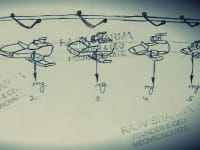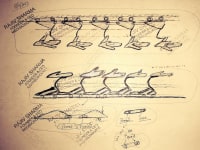Problem Statement
Thrust developed by engines of an aircraft is used to propel it in a forward direction. Its size or wing size that produces the required lift force to fulfill the need to hover a plane against the force of gravity is proportional to payload or overall weight. But lift force is not responsible for forward motion of the aircraft or used during liftoff, cruising and landing that are the parts of flight and if an airplane runs on ground without requirement of lift force it will travel same distance in less time.
Solution Statement
A Road In The Air For Aircraft.
In this innovation, lift force has been used to thrust the vehicle and to increase the overall efficiency.
Three parts of flight have been shown in the image.
This transportation system is categorized in two parts on the basis of track.
A. Track in the air, upward lift into thrust.
B. Track on the ground, downward lift into thrust.
Track in the air that converts upward lift force into thrust. In first phase of flight named as takeoff, upward lift will be converted into thrust. In middle phase of the flight named as cruising or hovering, lift force becomes equal to gravitational force, so there are no stresses on track in this phase. But as the lift force starts working it will be converted into the thrust.
Track on ground that converts downward lift force into thrust. In this category both gravitational and downward lift forces have same direction of action so have been added and will convert into thrust. The excessive downward force on track will develop compression stress on links or on ground so stresses can easily bear.
Concluded that efficiency of Track on ground has more efficiency than Track in the air.
Note:
Single Track or overhead tracks in air can be used for both cases. Lower and upper side of this track will be used for Track on ground & Track in the air respectively.Also vehicles can be independent or continue linked to each other like railway. For continue linked vehicles inertia force will be more.
Like this entry?
-
About the Entrant
- Name:Rajiv Sharma
- Type of entry:individual
- Patent status:pending








